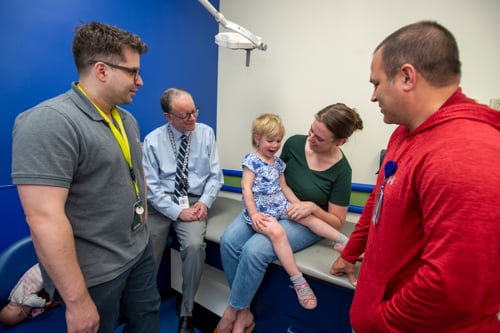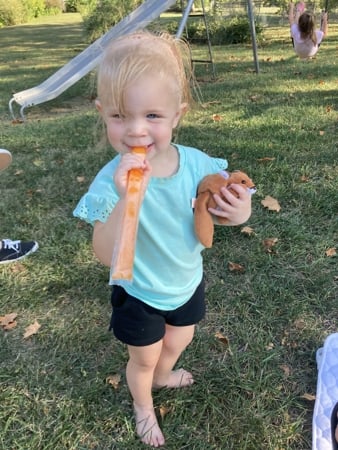Metopic Craniosynostosis: Geneva’s Story
Meet Geneva

“I know it’s scary, but we’re not scared.” Those words of reassurance from nurse practitioner Kelly Patterson, MSN, RN, CPNP-PC, made all the difference for Amy when she first took her daughter to the Plastic Surgery Clinic for skull growth concerns.
Geneva, who goes by Evie, is a spunky, opinionated 2-year-old with a unique sense of style. “She wore her purple light-up tutu and hooded unicorn robe to church one Sunday,” Amy shared. At Evie’s 18-month check-up, her pediatrician noticed something else unique about Evie: Her head shape was a little different than expected. They referred the family to Children’s Mercy Kansas City for further assessment.
At their first visit, Amy was surprised to learn that Evie had a condition called metopic craniosynostosis. This happens when different sections of the skull fuse together too early during fetal development and cause a pointed shape in the middle of the forehead. If left untreated, it can affect brain development and put pressure on the optic nerve, causing vision loss.
“All babies have openings in the skull called sutures, which are kind of like growth plates,” said Kelly, the nurse practitioner who diagnosed Evie in the Craniofacial Program . “Sometimes, one of those can close too early, and that was the case with Geneva.”
Evie had a closure of her metopic suture, which runs from the soft spot down to the top of the nose. Kelly said the first thing she asks parents when they come to the clinic is: “Have you Googled this? What did you learn online?” Because online sources can be unreliable, Kelly explained that she spends time unpacking what they’ve read and repacking it back in correctly.
Rough days now, better days ahead

Amy and her husband, Mike, were overwhelmed by the new diagnosis, but after asking lots of questions, they decided to go ahead with surgical correction for Evie’s skull. “This condition is not just cosmetic, it’s correcting a medical issue,” Amy said. “In the future, I didn’t want Evie to wonder why we didn’t get it fixed when we had the chance.”
Evie’s surgeons, plastic surgeon Jeffrey Goldstein, MD, and neurosurgeon David Garcia, MD, worked in tandem to place in her forehead to reshape the affected area. This will give her brain plenty of room to grow and develop.
Recovery from surgery was pretty rough the first three days, Amy recalled. “Evie was very swollen, and her eyes swelled shut,” said Amy. “That was the hardest part for her and for me.” But by day four, Evie was able to open her eyes a little bit, and before long, she was back to her old self.
“I knew the nursing staff in the hospital would be great, but I was constantly impressed by how much they cared about Evie and me,” Amy shared. That top-notch care continues at Evie’s follow-up visits, where she comes back to see her Plastic Surgery team every six to 12 months.
Evie shines bright

“Geneva is just a little sparkler,” said Kelly. “She always has a big smile and is easygoing and interactive at her visits.” Kelly and the Plastic Surgery team will continue to check in with Evie as she grows, until around age 5 to 8. The Neurosurgery team also sends out a survey to patients when they are older to ask follow-up questions and see how satisfied they are with their outcomes.
People often think of Plastics as just about appearances, Kelly said, but the holistic approach of the clinics means they consider all aspects of the child’s wellbeing. “We often say our patients wear their diagnosis, so in many ways, we are the face of the hospital,” she added, “and we are sought out for our multidisciplinary clinics by a six-state region.”
While it’s possible Evie will need a minor procedure in the future to correct any remaining narrowing in her forehead, for the most part, she won’t have to worry about her condition down the road.
“Evie is so resilient,” Amy said. “This whole process was harder on me than on her!” But with the calm, skillful support of their Plastic Surgery team, the whole family came through the experience even stronger.
